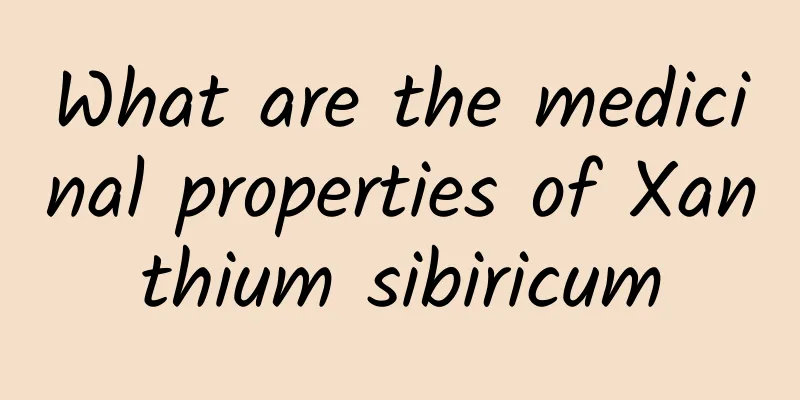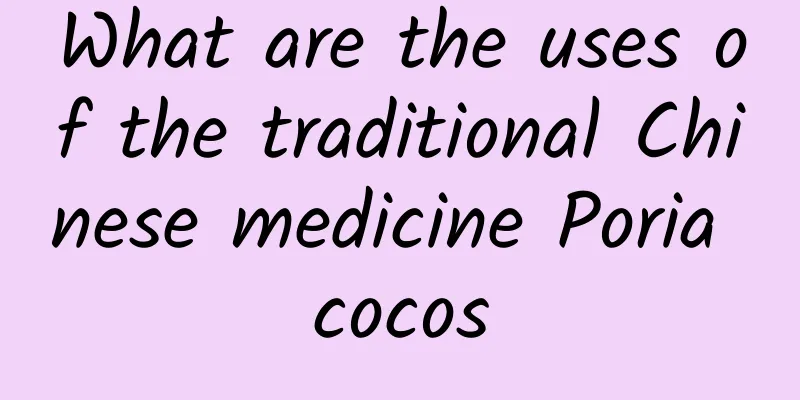What are the medicinal properties of Xanthium sibiricum

|
Xanthium sibiricum is a traditional Chinese medicine with so many names that we can’t count them all. The reason why it has so many names is that Xanthium sibiricum is very common in many regions of my country, so it is called differently in different regions. Although it has many names, all you need to remember is that Xanthium sibiricum has many functions. It can not only treat dizziness, but also treat skin itching. So, what are the medicinal properties of Xanthium sibiricum? Medicinal value 1. Used for sinusitis headache and wind-cold headache. This product is mild and soothing, pungent in taste to dispel wind, bitter in taste to dry dampness and turbidity, open the orifices and relieve pain. It is used to treat nasal sinusitis, headache, inability to smell fragrance or odor, and occasional turbid nasal discharge. It is often used together with magnolia, angelica dahurica, and mint, namely, Xanthium sibiricum powder. It is used to treat exogenous wind-cold, aversion to cold without sweating, headache and nasal congestion. It can be used together with Ledebouriella, Angelica dahurica, Notopterygium wilfordii, and Ligusticum chuanxiong. 2. Used for rheumatic pain. This product can dispel wind and dampness, dredge meridians and relieve pain. It is used to treat rheumatic arthralgia and cramps in the limbs. It can be used alone or together with Qinjiao, Cansha, Biqu, etc., and taken orally by soaking in wine, such as Shi Guogong Medicinal Wine. In addition, this product can be used together with Kochia scoparia, Dictamni cortex, Tribulus terrestris and other medicines to treat itching caused by rubella. This product can also be ground into powder and made into pills with cyperus rotundus oil. It can also treat scabies, leprosy, and all of them have the effect of dispersing wind and dampness. toxicity Mechanism of poisoning The whole plant is poisonous, with the young shoots and fruits being the most toxic. The stems and leaves contain substances that are toxic to the nerves and muscles. The mechanism of poisoning is not yet fully understood. The seed kernels and cotyledons contain toxic proteins and glycosides, which may be the main toxic components and can damage the heart, liver, and kidneys and cause bleeding. The main cause of poisoning is accidental ingestion of Xanthium sibiricum fruits or seedlings (mistaken for bean sprouts). If you want to use it as medicine, please see your doctor and follow his/her instructions strictly. The incubation period of Xanthium sibiricum poisoning varies depending on the ingested food and is generally 2 to 3 days, but can be as rapid as 4 hours. For example, those who eat raw Xanthium sibiricum directly will become ill 4 to 8 hours after eating, those who eat Xanthium sibiricum cakes will become ill 10 to 24 hours after eating, and those who eat seedlings will become ill 1 to 5 days after eating. Detoxification methods 1. When there is no gastrointestinal bleeding, induce vomiting, use 1:5000 potassium permanganate solution for gastric lavage, and take magnesium sulfate orally for catharsis. If a large amount is taken for more than 4 hours, high enema with 1% to 2% saline should be used as soon as possible. 2. Intravenous drip of 5% glucose saline and drink plenty of sugar water. The amount of infusion should be limited if patients suffer from heart failure, pulmonary edema or urinary retention. 3. If bleeding occurs, give hemostatic agents such as blood-enriching vitamin K, and blood transfusion if necessary. 4. When the liver shows obvious damage, hormones and blood-enriching vitamins B1, B12, C and other liver-protecting drugs can be given for health care. During the treatment and testing period, fat breast augmentation foods and herpes are temporarily prohibited, and other symptomatic treatments and testing are performed. So, how can we avoid poisoning when taking Xanthium sibiricum? What needs to be noted is that while taking Xanthium sibiricum, you must not eat pork, because eating pork and Xanthium sibiricum together will cause poisoning. There are many ways to eat Xanthium sibiricum, but it cannot be made into cakes, and you should not eat its leaves or fruits casually, because they are highly toxic. |
<<: What are the medicinal properties of Luobu Ma?
>>: What are the medicinal properties of Cassia seed?
Recommend
Why can’t we see the far side of the moon from Earth? How difficult is it for Chang’e-6 to land on the far side of the moon?
Why can't we see the far side of the moon fro...
What is the medicinal value of the hawksbill turtle?
Speaking of hawksbill turtles, I believe that few...
What are the effects and functions of Xiaohunxiang?
Cumin is a herb also known as fennel. There are m...
What is Wulingzhi
What is Wulingzhi? I believe many friends are con...
Health Tips | What is the reason for "sleep paralysis"? Here is the scientific explanation
Many people have experienced this situation: when...
Can Polygonum multiflorum be eaten raw?
Many people eat Polygonum multiflorum in differen...
What are the side effects of using Platycladus orientalis leaves to wash your hair?
In fact, using Pleurotus eryngii leaves to wash y...
How much is the dosage of placenta?
Placenta is a very good medicinal material. In fa...
The culprit of premature graying has been caught! Can gray hair turn black again?
Recently, a short video of a senior high school s...
After the Spring Festival, be careful of the "health killers" hidden in the refrigerator!
Before I knew it, the Spring Festival holiday was...
Allergy Revelation: Why are more and more people suffering from allergies?
© Buckhead Primary and Urgent Care Clinic Leviath...
What are the medicinal values of agarwood?
Agarwood is also called incense material, daughte...
These animals remain in my memory...
Recently, the World Conservation Union’s Red List...
The efficacy and function of bergamot bark
Chinese medicinal materials are very effective in...
The efficacy and effects of opium
For many Chinese people, traditional Chinese medi...









